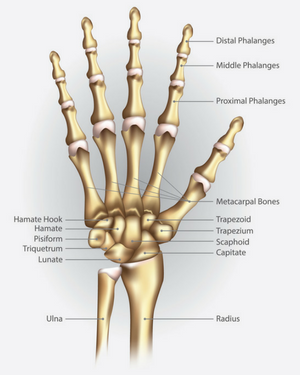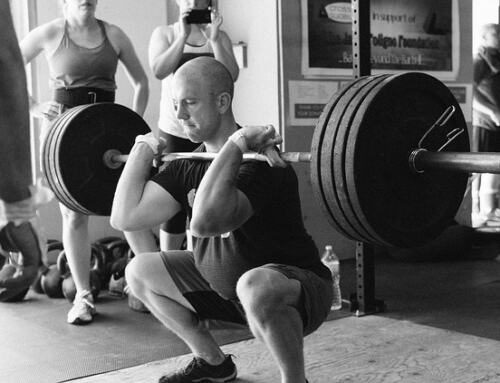Why You Need Good Wrist Mobility
The wrist is an area of the body, and yet we don’t often think about it when we’re training. However, it plays an important role in upper body function.
If you’ve ever had wrist pain in a push-up or a plank, or felt like it was hard to grip the bar in a bodyweight exercise, then you might have some limitations in wrist mobility that you weren’t aware of.
Even if you don’t have wrist pain, wrist mobility is still beneficial to work on, because every time you lift an object — be it a dumbbell or a coffee cup — your wrist is involved. Furthermore, since poor wrist mobility can contribute to forearm, elbow, and shoulder issues, working on your wrists can improve overall upper body strength and function.
We’re going to discuss how to identify and address wrist mobility issues, but first, it helps to know a little more about the anatomy of this area.
Anatomy of the Forearm and Primary Movements of the Wrist
The wrist is a synovial joint where the forearm and hand meet. It is comprised of the lower part of the radius and ulna, which are the two bones in the forearm, and the first row of bones in the hand, minus the pisiform.
The muscles of the forearm travel across the wrist and connect to the hand, creating wrist movement when they contract. Many of them attach near the elbow and upper forearm, which is why wrist mobility can influence grip strength, and elbow and shoulder function.
The primary movements of the wrist are flexion and extension. Wrist flexion occurs when you bend your wrist to move your fingers towards your palm. Wrist extension occurs when you pull your fingers back towards your body. Making a stop motion  with your hand is a good example of wrist extension.
with your hand is a good example of wrist extension.
The muscles located on the front of forearm or the palm side hand are responsible for wrist flexion. They include the flexor carpi radialis, palmaris longus, flexor carpi ulnaris, and flexor digitorum superficialis.
The muscles located on the back of the forearm are responsible for wrist extension. They include the extensor carpi ulnaris, extensor carpi radialis longus and the extensor digitorum.
The wrist can also move side to side in adduction and abduction. Wrist adduction occurs when the wrist bends so that the pinkie finger side of the wrist shortens. The opposite motion, wrist abduction, occurs when the wrist bends so that the thumb side of the wrist shortens. Some of the wrist flexors and extensors also work with muscles in the hand for wrist abduction and adduction.
It is also important to note the actions of the forearm, because of its role in wrist mobility. The forearm can supinate and pronate. If your elbow is bent by your side, forearm pronation occurs when the forearm spins in, so the palm faces the floor. Forearm supination occurs when the forearm spins out, so the palm faces the ceiling.
Causes of Limited Wrist Mobility
 Many strength exercises and activities of our daily life tend to keep us in forearm pronation and wrist extension. Computer work, for example, is a combination of pronation with wrist extension. Many yoga poses and bodyweight exercises like planks and push-ups also put us in wrist extension with forearm pronation. Any barbell lift using an overhand grip also involves forearm pronation.
Many strength exercises and activities of our daily life tend to keep us in forearm pronation and wrist extension. Computer work, for example, is a combination of pronation with wrist extension. Many yoga poses and bodyweight exercises like planks and push-ups also put us in wrist extension with forearm pronation. Any barbell lift using an overhand grip also involves forearm pronation.
As a result, we tend to be strong in our wrist extensors and forearm pronators and weak in our wrist flexors and forearm supinators. This muscle imbalance — combined with the repetitive positioning of our arms — can lead to limited wrist mobility, because we tend to lose mobility in the positions where we’re weak. It is thought that this limited mobility is our nervous system’s way of trying to protect us from injury, should we attempt to reach a position that we’re not strong enough to hold [1].
 This also contributes to wrist pain: without good mobility, it’s harder to load the wrist in a good position when we put weight into our hands. This imbalance affects grip strength as well, because the forearm flexors assist in our ability to grip and hang from things and help us access back muscles and shoulder stabilizers, including the latissimus dorsi and lower trapezius.
This also contributes to wrist pain: without good mobility, it’s harder to load the wrist in a good position when we put weight into our hands. This imbalance affects grip strength as well, because the forearm flexors assist in our ability to grip and hang from things and help us access back muscles and shoulder stabilizers, including the latissimus dorsi and lower trapezius.
Traumatic injury, as well as soft tissue or bony restrictions, can also create limitations in wrist mobility.
How to Assess Wrist Mobility
To get a clinical assessment of your wrist — which is out of the scope of a fitness professional — you’ll need to consult a medical professional. However, the video below demonstrates some simple assessments that you can do at home, which would indicate if you have some limitations in your wrist mobility.
Other Signs of Limited Wrist Mobility
There are additional signs, during movement, which suggest limited wrist mobility:
- Feeling compression or pain in the wrist when you are on your hands and knees, or in a plank position.
- A tendency to set yourself up in planks with your hands more in line with your head than your shoulders.
- Difficulty straightening your elbows when you are on your hands and knees.
How to Improve Wrist Mobility
There are several ways to address wrist mobility, depending on the underlying cause of the limitation.
If you have a bony or more severe soft tissue restriction, you may need hands-on treatment from a physical therapist or massage therapist. If you suspect you have an injury, or are experiencing pain and swelling, you should see a medical provider for diagnosis and treatment.
If you don’t have pain and your limitations are minor, then gentle stretching, combined with mobility and strength exercises focusing on the forearm, wrist, and hand, can be used to help yourself or your clients improve wrist mobility and grip strength.
Additionally, it can be beneficial to use supination or an underhand grip when lifting to create better balance in the forearm. For example, when targeting your biceps, you could do a concentration curl, where you spin the forearm from pronation to supination as you bend your elbow. You could also use an underhand grip during exercises, such as preacher curls, skull crushers and chin ups.
Coaches’ Corner
If you notice that your client has signs of limited wrist mobility or they mention wrist discomfort, how can you help them?
For general stiffness or difficulty extending the wrist during exercises like planks, push-ups or front squats, it may be beneficial to incorporate gentle wrist mobility and strength exercises, such as the ones above, into the warm-up. You can also recommend that your client practice one or two of these exercises at home, because it takes consistent practice and time to improve mobility.
If your client is experiencing pain, doesn’t see noticeable improvement, or has significant restrictions, then they might benefit from massage or physical therapy. In these situations, you want to refer your client to the appropriate medical professional, because as a fitness professional, hands-on manipulation, diagnosis of pain and treatment, are out of your scope of practice.
Click here to view original web page at www.girlsgonestrong.com





